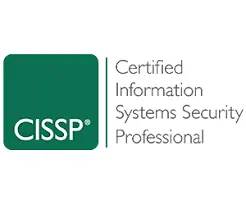ExamPrep ISC2 CISSP
Offline or Online ISC2 CISSP (Certified Information Systems Security Professional) ExamPrep training course.
The Certified Information Systems Security Professional (CISSP) is a globally recognized certification for experienced cybersecurity professionals, issued by (ISC)². It validates a professional's managerial and technical skills to design, engineer, and manage an organization's overall security posture.
A CISSP Certification is essential for professionals in information security, cybersecurity, and IT management roles. As cyber threats continue to evolve, mastering CISSP becomes a key competency. This course is particularly important for professionals aiming to advance their careers in information security, secure high-profile roles, and demonstrate their expertise in designing, implementing, and managing a robust cybersecurity program.

Manoj S. Mahajan
28+ years Experienced Trainer with 100+ certs, View full profile....Course Description
This CISSP Course is designed to efficiently prepare delegates for the CISSP exam. Participants will gain insights into the core domains of information security, covering topics such as security and risk management, asset security, and communication and network security.
This training course equips delegates with the knowledge and strategies to successfully pass the CISSP exam.
Why join our ISC2 ExamPrep training?
- Instructor-led ExamPrep training with ISC2 Certified trainer.
- Hands‑on labs to reinforce theory with practice
- Exam practice questions at the end of each lecture
- Mock exams to prepare for certification success
- Real‑world project simulations for practical experience

Audience:
- IT professionals, students, and anyone exploring a career in cybersecurity or preparing for CISSP certification.
- For those aiming to pass the ISC2 CISSP certification exam.
Certified Information Systems Security Professional (CISSP) Exam details:
The CISSP exam uses Computerized Adaptive Testing (CAT) for all exams.- Passing score: 700 out of 1000 points
- Number of items: 100 - 150
- Format: Multiple choice and advanced items
- Length of exam: 3 hours
Key Features
- Real-time 1 to 1 interaction
- Download short notes
- Get the source code after each lecture
- Get an attendance certificate

Syllabus
Please check the syllabus tab above. ☝- Domain 1: Security and Risk Management (16% Average Weight)
- Domain 2: Asset Security (10% Average Weight)
- Domain 3: Security Architecture and Engineering (13% Average Weight)
- Domain 4: Communication and Network Security (13% Average Weight)
- Domain 5: Identity and Access Management (IAM) (13% Average Weight)
- Domain 6: Security Assessment and Testing (12% Average Weight)
- Domain 7: Security Operations (13% Average Weight)
- Domain 8: Software Development Security (10% Average Weight)
What You'll Learn in this training
Domain 1: Security and Risk Management
1.1 - Understand, adhere to, and promote professional ethics
- ISC2 Code of Professional Ethics
- Organizational code of ethics
1.2 - Understand and apply security concepts
- Confidentiality, integrity, and availability, authenticity, and nonrepudiation (5 Pillars of Information Security)
1.3 - Evaluate and apply security governance principles
- Alignment of the security function to business strategy, goals, mission, and objectives
- Organizational processes (e.g., acquisitions, divestitures, governance committees)
- Organizational roles and responsibilities
- Security control frameworks (e.g., International Organization for Standardization (ISO), National Institute of Standards and Technology (NIST), Control Objectives for Information and Related Technology (COBIT), Sherwood Applied Business Security Architecture (SABSA), Payment Card Industry (PCI), Federal Risk and Authorization Management Program (FedRAMP))
- Due care/due diligence
1.4 - Understand legal, regulatory, and compliance issues that pertain to information security in a holistic context
- Cybercrimes and data breaches
- Licensing and Intellectual Property requirements
- Import/export controls
- Transborder data flow
- Issues related to privacy (e.g., General Data Protection Regulation (GDPR), California Consumer Privacy Act, Personal Information Protection Law, Protection of Personal Information Act)
- Contractual, legal, industry standards, and regulatory requirements
1.5 - Understand requirements for investigation types (i.e., administrative, criminal, civil, regulatory, industry standards)
1.6 - Develop, document, and implement security policy, standards, procedures, and guidelines
1.7 - Identify, analyze, assess, prioritize, and implement Business Continuity (BC) requirements
- Business impact analysis (BIA)
- External dependencies
1.8 - Contribute to and enforce personnel security policies and procedures
- Candidate screening and hiring
- Employment agreements and policy driven requirements
- Onboarding, transfers, and termination processes
- Vendor, consultant, and contractor agreements and controls
1.9 - Understand and apply risk management concepts
- Threat and vulnerability identification
- Risk analysis, assessment, and scope
- Risk response and treatment (e.g., cybersecurity insurance)
- Applicable types of controls (e.g., preventive, detection, corrective)
- Control assessments (e.g., security and privacy)
- Continuous monitoring and measurement
- Reporting (e.g., internal, external)
- Continuous improvement (e.g., risk maturity modeling)
- Risk frameworks (e.g., International Organization for Standardization (ISO), National Institute of Standards and Technology (NIST), Control Objectives for Information and Related Technology (COBIT), Sherwood Applied Business Security Architecture (SABSA), Payment Card Industry (PCI))
1.10 - Understand and apply threat modeling concepts and methodologies
1.11 - Apply Supply Chain Risk Management (SCRM) concepts
- Risks associated with the acquisition of products and services from suppliers and providers (e.g., product tampering, counterfeits, implants)
- Risk mitigations (e.g., third-party assessment and monitoring, minimum security requirements, service level requirements, silicon root of trust, physically unclonable function, software bill of materials)
1.12 - Establish and maintain a security awareness, education, and training program
- Methods and techniques to increase awareness and training (e.g., social engineering, phishing, security champions, gamification)
- Periodic content reviews to include emerging technologies and trends (e.g., cryptocurrency, artificial intelligence (AI), blockchain)
- Program effectiveness evaluation
Domain 2: Asset Security
2.1 - Identify and classify information and assets
- Data classification
- Asset Classification
2.2 - Establish information and asset handling requirements
2.3 - Provision information and assets securely
- Information and asset ownership
- Asset inventory (e.g., tangible, intangible)
- Asset management
2.4 - Manage data lifecycle
- Data roles (i.e., owners, controllers, custodians, processors, users/subjects)
- Data collection
- Data location
- Data maintenance
- Data retention
- Data remanence
- Data destruction
2.5 - Ensure appropriate asset retention (e.g., End of Life (EOL), End of Support)
2.6 - Determine data security controls and compliance requirements
- Data states (e.g., in use, in transit, at rest)
- Scoping and tailoring
- Standards selection
- Data protection methods (e.g., Digital Rights Management (DRM), Data Loss Prevention (DLP), Cloud Access Security Broker (CASB))
Domain 3: Security Architecture and Engineering
3.1 - Research, implement and manage engineering processes using secure design principles
- Threat modeling
- Least privilege
- Defense in depth
- Secure defaults
- Fail securely
- Segregation of Duties (SoD)
- Keep it simple and small
- Zero trust or trust but verify
- Privacy by design
- Shared responsibility
- Secure access service edge
3.2 - Understand the fundamental concepts of security models (e.g., Biba, Star Model, Bell-LaPadula)
3.3 - Select controls based upon systems security requirements
3.4 - Understand security capabilities of Information Systems (IS) (e.g., memory protection, Trusted Platform Module (TPM), encryption/decryption)
3.5 - Assess and mitigate the vulnerabilities of security architectures, designs, and solution elements
- Client-based systems
- Server-based systems
- Database systems
- Cryptographic systems
- Industrial Control Systems (ICS)
- Cloud-based systems (e.g., Software as a Service (SaaS), Infrastructure as a Service (IaaS), Platform as a Service (PaaS))
- Distributed systems
- Internet of Things (IoT)
- Microservices (e.g., application programming interface (API))
- Containerization
- Serverless
- Embedded systems
- High-Performance Computing systems
- Edge computing systems
- Virtualized systems
3.6 - Select and determine cryptographic solutions
- Cryptographic life cycle (e.g., keys, algorithm selection)
- Cryptographic methods (e.g., symmetric, asymmetric, elliptic curves, quantum)
- Public key infrastructure (PKI) (e.g., quantum key distribution)
3.7 - Understand methods of cryptanalytic attacks
- Brute force
- Ciphertext only
- Known plaintext
- Frequency analysis
- Chosen ciphertext
- Implementation attacks
- Side-channel
- Fault injection
- Timing
- Man-in-the-Middle (MITM)
- Pass the hash
- Kerberos exploitation
- Ransomware
3.8 - Apply security principles to site and facility design
3.9 - Design site and facility security controls
- Wiring closets/intermediate distribution facilities
- Server rooms/data centers
- Media storage facilities
- Evidence storage
- Restricted and work area security
- Utilities and Heating, Ventilation, and Air Conditioning (HVAC)
- Environmental issues (e.g., natural disasters, man-made)
- Fire prevention, detection, and suppression
- Power (e.g., redundant, backup)
3.10 - Manage the information system lifecycle
- Stakeholders needs and requirements
- Requirements analysis
- Architectural design
- Development /implementation
- Integration
- Verification and validation
- Transition/deployment
- Operations and maintenance/sustainment
- Retirement/disposal
Domain 4: Communication and Network Security
4.1 - Apply secure design principles in network architectures
- Open System Interconnection (OSI) and Transmission Control Protocol/Internet Protocol (TCP/IP) models
- Internet Protocol (IP) version 4 and 6 (IPv6) (e.g., unicast, broadcast, multicast, anycast)
- Secure protocols (e.g., Internet Protocol Security (IPSec), Secure Shell (SSH), Secure Sockets Layer (SSL)/ Transport Layer Security (TLS))
- Implications of multilayer protocols
- Converged protocols (e.g., Internet Small Computer Systems Interface (iSCSI), Voice over Internet Protocol (VoIP), InfiniBand over Ethernet, Compute Express Link)
- Transport architecture (e.g., topology, data/control/management plane, cut-through/store-and-forward)
- Performance metrics (e.g., bandwidth, latency, jitter, throughput, signal-to-noise ratio)
- Traffic flows (e.g., north-south, east-west)
- Physical segmentation (e.g., in-band, out-of-band, air-gapped)
- Logical segmentation (e.g., virtual local area networks (VLANs), virtual private networks (VPNs), virtual routing and forwarding, virtual domain)
- Micro-segmentation (e.g., network overlays/encapsulation; distributed firewalls, routers, intrusion detection system (IDS)/intrusion prevention system (IPS), zero trust)
- Edge networks (e.g., ingress/egress, peering)
- Wireless networks (e.g., Bluetooth, Wi-Fi, Zigbee, satellite)
- Cellular/mobile networks (e.g., 4G, 5G)
- Content distribution networks (CDN)
- Software defined networks (SDN), (e.g., application programming interface (API), Software-Defined Wide- Area Network, network functions virtualization)
- Virtual Private Cloud (VPC)
- Monitoring and management (e.g., network observability, traffic flow/shaping, capacity management, fault detection and handling)
4.2 - Secure network components
- Operation of infrastructure (e.g., redundant power, warranty, support)
- Transmission media (e.g., physical security of media, signal propagation quality)
- Network Access Control (NAC) systems (e.g., physical, and virtual solutions)
- Endpoint security (e.g., host-based)
4.3 - Implement secure communication channels according to design
- Voice, video, and collaboration (e.g., conferencing, Zoom rooms)
- Remote access (e.g., network administrative functions)
- Data communications (e.g., backhaul networks, satellite)
- Third-party connectivity (e.g., telecom providers, hardware support)
Domain 5: Identity and Access Management (IAM)
5.1 - Control physical and logical access to assets
- Information
- Systems
- Devices
- Facilities
- Applications
- Services
5.2 - Design identification and authentication strategy (e.g., people, devices, and services)
- Groups and Roles
- Authentication, Authorization and Accounting (AAA) (e.g., multi-factor authentication (MFA), password-less authentication)
- Session management
- Registration, proofing, and establishment of identity
- Federated Identity Management (FIM)
- Credential management systems (e.g., Password vault)
- Single sign-on (SSO)
- Just-In-Time
5.3 - Federated identity with a third-party service
- On-premise
- Cloud
- Hybrid
5.4 - Implement and manage authorization mechanisms
- Role-based access control (RBAC)
- Rule based access control
- Mandatory access control (MAC)
- Discretionary access control (DAC)
- Attribute-based access control (ABAC)
- Risk based access control
- Access policy enforcement (e.g., policy decision point, policy enforcement point)
5.5 - Manage the identity and access provisioning lifecycle
- Account access review (e.g., user, system, service)
- Provisioning and deprovisioning (e.g., on /off boarding and transfers)
- Role definition and transition (e.g., people assigned to new roles)
- Privilege escalation (e.g., use of sudo, auditing its use)
- Service accounts management
5.6 - Implement authentication systems
Domain 6: Security Assessment and Testing
6.1 - Design and validate assessment, test, and audit strategies
- Internal (e.g., within organization control)
- External (e.g., outside organization control)
- Third-party (e.g., outside of enterprise control)
- Location (e.g., on-premises, cloud, hybrid)
6.2 - Conduct security control testing
- Vulnerability assessment
- Penetration testing (e.g., red, blue, and/or purple team exercises)
- Log reviews
- Synthetic transactions/benchmarks
- Code review and testing
- Misuse case testing
- Coverage analysis
- Interface testing (e.g., user interface, network interface, application programming interface (API))
- Breach attack simulations
- Compliance checks
6.3 - Collect security process data (e.g., technical and administrative)
- Account management
- Management review and approval
- Key performance and risk indicators
- Backup verification data
- Training and awareness
- Disaster Recovery (DR) and Business Continuity (BC)
6.4 - Analyze test output and generate report
- Remediation
- Exception handling
- Ethical disclosure
6.5 - Conduct or facilitate security audits
- Internal (e.g., within organization control)
- External (e.g., outside organization control)
- Third-party (e.g., outside of enterprise control)
- Location (e.g., on-premises, cloud, hybrid)
Domain 7: Security Operations
7.1 - Understand and comply with investigations
- Evidence collection and handling
- Reporting and documentation
- Investigative techniques
- Digital forensics tools, tactics, and procedures
- Artifacts (e.g., data, computer, network, mobile device)
7.2 - Conduct logging and monitoring activities
- Intrusion detection and prevention (IDPS)
- Security Information and Event Management (SIEM)
- Continuous monitoring and tuning
- Egress monitoring
- Log management
- Threat intelligence (e.g., threat feeds, threat hunting)
- User and Entity Behavior Analytics (UEBA)
7.3 - Perform Configuration Management (CM) (e.g., provisioning, baselining, automation)
7.4 - Apply foundational security operations concepts
- Need-to-know/least privilege
- Separation of Duties (SoD) and responsibilities
- Privileged account management
- Job rotation
- Service-level agreements (SLA)
7.5 - Apply resource protection
- Media management
- Media protection techniques
- Data at rest/data in transit
7.6 - Conduct incident management
- Detection
- Response
- Mitigation
- Reporting
- Recovery
- Remediation
- Lessons learned
7.7 - Operate and maintain detection and preventative measures
- Firewalls (e.g., next generation, web application, network)
- Intrusion Detection Systems (IDS) and Intrusion Prevention Systems (IPS)
- Whitelisting/blacklisting
- Third-party provided security services
- Sandboxing
- Honeypots/honeynets
- Anti-malware
- Machine learning and Artificial Intelligence (AI) based tools
7.8 - Implement and support patch and vulnerability management
7.9 - Understand and participate in change management processes
7.10 - Implement recovery strategies
- Backup storage strategies (e.g., cloud storage, onsite, offsite)
- Recovery site strategies (e.g., cold vs. hot, resource capacity agreements)
- Multiple processing sites
- System resilience, high availability (HA), Quality of Service (QoS), and fault tolerance
7.11 - Implement Disaster Recovery (DR) processes
- Response
- Personnel
- Communications (e.g., methods)
- Assessment
- Restoration
- Training and awareness
- Lessons learned
7.12 - Test Disaster Recovery Plans (DRP)
- Read-through/tabletop
- Walkthrough
- Simulation
- Parallel
- Full interruption
- Communications (e.g., stakeholders, test status, regulators)
7.13 - Participate in Business Continuity (BC) planning and exercises
7.14 - Implement and manage physical security
- Perimeter security controls
- Internal security controls
7.15 - Address personnel safety and security concerns
- Travel
- Security training and awareness (e.g., insider threat, social media impacts, two-factor authentication (2FA) fatigue)
- Emergency management
- Duress
Domain 8: Software Development Security
8.1 - Understand and integrate security in the Software Development Life Cycle (SDLC)
- Development methodologies (e.g., Agile, Waterfall, DevOps, DevSecOps, Scaled Agile Framework)
- Maturity models (e.g., Capability Maturity Model (CMM), Software Assurance Maturity Model (SAMM))
- Operation and maintenance
- Change management
- Integrated Product Team
8.2 - Identify and apply security controls in software development ecosystems
- Programming languages
- Libraries
- Tool sets
- Integrated Development Environment
- Runtime
- Continuous Integration and Continuous Delivery (CI/CD)
- Software configuration management (CM)
- Code repositories
- Application security testing (e.g., static application security testing (SAST), dynamic application security testing (DAST), software composition analysis, Interactive Application Security Test (IAST))
8.3 - Assess the effectiveness of software security
- Auditing and logging of changes
- Risk analysis and mitigation
8.4 - Assess security impact of acquired software
- Commercial-off-the-shelf (COTS)
- Open source
- Third-party
- Managed services (e.g., enterprise applications)
- Cloud services (e.g., Software as a Service (SaaS), Infrastructure as a Service (IaaS), Platform as a Service (PaaS))
8.5 - Define and apply secure coding guidelines and standards
- Security weaknesses and vulnerabilities at the source-code level
- Security of application programming interfaces (API)
- Secure coding practices
- Software-defined security

Jatin
Training was excellent. Learned things which are helpful in day to day tasks. trainer knowledge level is also excellent. Read more....

Nagesh
I have learn new technology & it is very important for my future life. This institute is best for the IT life. Read more....

Sachin
It was very good experience. Manoj sir's focus on basics helps me to grasp knowledge very quickly and efficiently. Sir not only focused on theory but gave different practicle example which really helpful. I definitely recommend this training to my colleagues. Read more....




